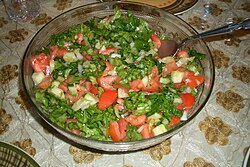 | |
| Type | Salad |
|---|---|
| Course | Mezze |
| Main ingredients | Vegetables, spices |
Arab salad or Arabic salad is any of a variety of salad dishes that form part of Arab cuisine. Combining many different fruits and spices, and often served as part of a mezze, Arab salads include those from Libya and Tunisia such as the "Tunisian salad" and "black olive and orange salad" (salatat zaytoon) and from Tunisia salata machwiya is a grilled salad made from peppers, tomatoes, garlic and onions with olives and tuna on top, those from Syria and Lebanon such as "artichoke salad" (salataf khurshoof) and "beet salad" (salatat shamandar), and those from Palestine and Jordan.[1] Other popular Arab salads eaten throughout the Arab world include fattoush and tabouli.[2][3]
A recipe for Arab salad in Woman's Day magazine includes diced tomato, cucumber and onion.[4] Often mixed with parsley and combined with the juice of freshly squeezed lemon and olive oil, Arabic salad contains no lettuce. All the vegetables, except the onion, are left unpeeled, and the salad should be served immediately. Other variations include serving with fried pita slices or adding sumac to the lemon and oil dressing.[5] Among Palestinians, this Arabic salad is known as Salatat al-Bundura ("tomato salad") and is popularly served alongside rice dishes.[6][7]
Similar salads in the Middle East include the Persian, Israeli salad, salad shirazi, Turkish choban salad and Greek salad.
See also[edit]
- Afghan salad, a similar salad from Afghanistan
- Çoban salatası, a similar salad from Turkey
- Greek salad, a similar salad from Greece
- Israeli salad, a similar salad from Israel
- Kachumbari, a similar salad from East Africa
- Kachumber, a similar salad from India
- Pico de gallo, a similar salsa from Mexico
- Serbian salad, a similar salad from Serbia
- Shirazi salad, a similar salad from Iran
- Shopska salad, a similar salad from Bulgaria
- List of Arabic salads
- List of hors d'oeuvre
References[edit]
- ^ Salloum et al., 1997, p. 56-58.
- ^ Shulman, 2007, p. 128.
- ^ Wright, 2001, p. 251.
- ^ Women's Day Magazine: Arabic Salad Archived July 6, 2011, at the Wayback Machine
- ^ "6abkhat Ummi: Recipes from Bahrain and the Rest of the Middle East: Sala6a - Arabic Salad". September 22, 2007.
- ^ Arabic Salad Recipe
- ^ Farsoun, 2004, p. 138.
Bibliography[edit]
- Farsoun, Samih K. (2004), Culture and Customs of the Palestinians (Illustrated ed.), Greenwood Publishing Group, ISBN 978-0-313-32051-4
- Salloum, Habeeb; Peters, James; Cassidy, Neal (1997), From the Lands of Figs and Olives: Over 300 Delicious and Unusual Recipes from the Middle East and North Africa (Illustrated ed.), I.B.Tauris, ISBN 978-1-86064-038-4
- Shulman, Martha Rose (2007), Mediterranean Harvest: Vegetarian Recipes from the World's Healthiest Cuisine (Illustrated ed.), Rodale, ISBN 978-1-59486-234-2
- Wright, Clifford A. (2001), Mediterranean Vegetables: A Cook's ABC of Vegetables and Their Preparation in Spain, France, Italy, Greece, Turkey, the Middle East, and North Africa with More Than 200 Authentic Recipes for the Home Cook (Illustrated ed.), Harvard Common Press, ISBN 978-1-55832-196-0
Well, that’s interesting to know that Psilotum nudum are known as whisk ferns. Psilotum nudum is the commoner species of the two. While the P. flaccidum is a rare species and is found in the tropical islands. Both the species are usually epiphytic in habit and grow upon tree ferns. These species may also be terrestrial and grow in humus or in the crevices of the rocks.
View the detailed Guide of Psilotum nudum: Detailed Study Of Psilotum Nudum (Whisk Fern), Classification, Anatomy, Reproduction